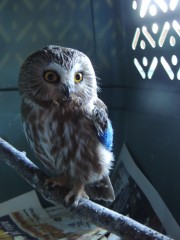
This Saw Whet Owl is recovering from a wing fracture. She is in a quiet location where she has minimal contact with humans.
Extended Rehabilitation
Injured hawks and owls can need care for many weeks, and often for months after we receive them. During that time, they may be on antibiotics, and they may have pins in their bones to keep them healing in line; they are monitored closely for any change in attitude or feeding habits, and when ready, are exercised to bring them into full flight capabilities. During this time, it is critical to keep them in a quiet location, away from people, and give them as little human contact as possible. To feed these birds while showing a human face destroys their wariness of people, and often means death to the hawk or owl after release. While initial care may require that the bird be handled daily, extended rehabilitation is always done with the “hands off” approach.
Housing during extended rehabilitation is also critical. Enclosures must be roomy, so that the bird can stretch its wings and begin to fly, and not hurt itself or its feathers. Damaged feathers need to be regrown before releasing the bird; it is much easier to prevent feather damage and loss. This is done by providing large outdoor cages with bars in the window. A strong perch is provided near the window, and often the window faces the woods. The bars are made from either hard plastic or wood; and in some cases they are hanging rather than stationary to prevent injury. These bars prevent the feather damage that will render the bird flightless.
Once the hawk or owl is moving well, and has shown its readiness to fly, it is moved to a flight cage. In the flight cage, it can build its flight muscles to prime condition. (Please see “Flight Cages”) in the menu.